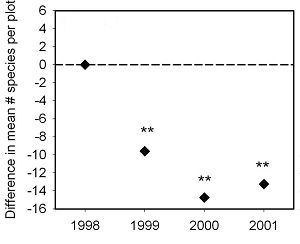The Qinghai-Tibetan plateau, well known as the “roof of the world”, has an average altitude over 4,000 m above sea level. With its peculiar topography, the Qinghai-Tibetan Plateau has a unique climate system that is very sensitive to these environmental changes, with air temperatures increasing at a rate of 0.16 °C, every ten years. Due to its high species richness and unique evolutionary mechanisms, Qinghai-Tibetan Plateau, along with southeast China, the Himalayan biodiversity hotspot, is not only designated as one of World’s 34 most important centers of biodiversity, but also considered the hotspot of adaptive evolution research. Little information is available by which we can assess how the grassland on the plateau will react to this change, thus simulated warming experiments have been performed in this region in order to understand the possible effect of ongoing climate warming on the vast grasslands on the plateau.
(1) Independent and combined effects of simulated warming on plant diversity
Within each of OTC’s experimental plots, a complete factorial experimental design was established where warming was simulated using fiberglass OTC’s. Simulated warming decreased total species richness by five to 14 species (depending on the habitat and the grazing history) in 1999, and by 9 to 15 species in 2001. This represents a 16-30% decline in species richness in 1999 and a 26-39% decline in species richness by 2001. Averaged across all sites, warming decreased the Shannon diversity index by four species (34%) in 2001 (Fig. 1). This is a preliminary study to explicitly examine the effects of experimental warming on the rangelands of the Qinghai-Tibetan Plateau, and its results suggest that the future of species diversity in this region will depend on both climate change and grazing management.

Fig. 1 Effect of warming on total species richness at the low grazing intensity history shrub
(2) Impact of simulated warming on the above-ground biomass
Open Top Chambers (OTC) are commonly employed to study the effect of climate warming on ecosystems. Almost all alpine meadow species could be categorized into graminoids, sedges, and forbs. The aboveground biomass of most gramineous plants such as Koeleria cristata, Festuca ovina, Festuca rubra, Poa sp., Stipa aliena, Elymus mutans increased. The aboveground biomass of most sedgy plants such as Kobresia humilis, Carex sp., Scirpus distigmaticus also increased. However, the contrary is true for forbs such as Gentiana straminea, Saussurea superba, Thalictrum alpinum, Gueldenstaedtia diversifolia, Gentiana farreri, Taraxacum sp., Potentilla bifurca and Potentilla nivea. Consequently, the aboveground biomass of graminoid and sedge species inside OTC’s increased by 12.3% and 1.18% over the control, respectively. However, in contrast, the aboveground biomass of forbs decreased by 21.13%. Numerous impacts on the phenology, growth, and physiological state of the vegetation in the plots have been observed. For example, forbs in heated plots show significant reductions in aboveground biomass. However, in our study, a simulated experiment on the alpine meadow on the Qinghai-Tibetan Plateau, forbs in heated plots showed a significant increase in aboveground biomass.
(3) The effects of simulated warming on the phenology
The phenological phases of the alpine meadow are affected significantly by increased temperatures. The growing phase of plant populations inside the OTC’s was delayed, on average, by 4.95 days. Beginning times for all phenological phases advanced, but ending times were delayed. This was especially true for the beginning of the fruit-bearing phase, which was advanced by 2.84 days, while the end of the vegetative phase, after the bearing of fruit, was delayed 5.74 days. However, the contrary was true for the florescence phase, with its beginning time delayed, and its ending time advanced. Perhaps this is due to the fact that the energy obtained during the sunlight hours, and the amount of sunshine available, was reduced by the fiberglass of the OTC’s.
The phenological phases of the alpine meadow are affected significantly by increased temperatures. The growing phase of plant populations inside the OTC’s was delayed, on average, by 4.95 days. Beginning times for all phenological phases advanced, but ending times were delayed. This was especially true for the beginning of the fruit-bearing phase, which was advanced by 2.84 days, while the end of the vegetative phase, after the bearing of fruit, was delayed 5.74 days. However, the contrary was true for the florescence phase, with its beginning time delayed, and its ending time advanced.
(4) Impact of simulated warming on herbage nutrition
Four sites with differing temperatures were selected at different altitudes of Daban Mountain in order to investigate the potential effect of climate warming on alpine herbage nutrient content. There are negative correlations between the temperature and CP contents of the herbage; as for ADF and ADL contents, there were positive correlations between temperature and ADF and ADL contents of the herbage. In this study, we selected sites that showed similar topography, soil type, and vegetation conditions, but that were located at different altitudes. Temperature differences, resulting from different altitudes, were the determining factor for all kinds of environmental elements. Thus, in this study, differences in the nutrient contents of herbage grown at different altitudes can be deduced as the response of herbage nutrients to differences in temperature. Therefore, differences in herbage CP, ADF, and ADL contents were primarily influenced by temperature, and the warming trends seen in the climate of the Tibetan Plateau over the last 40 years would enhance herbage respiration. This is especially true of increases in nighttime temperatures. This tends to work against the accumulation of some soluble matters such as protein, ether extract, and nitrogen free extract, and is better suited to the accumulation of insoluble lignin.
